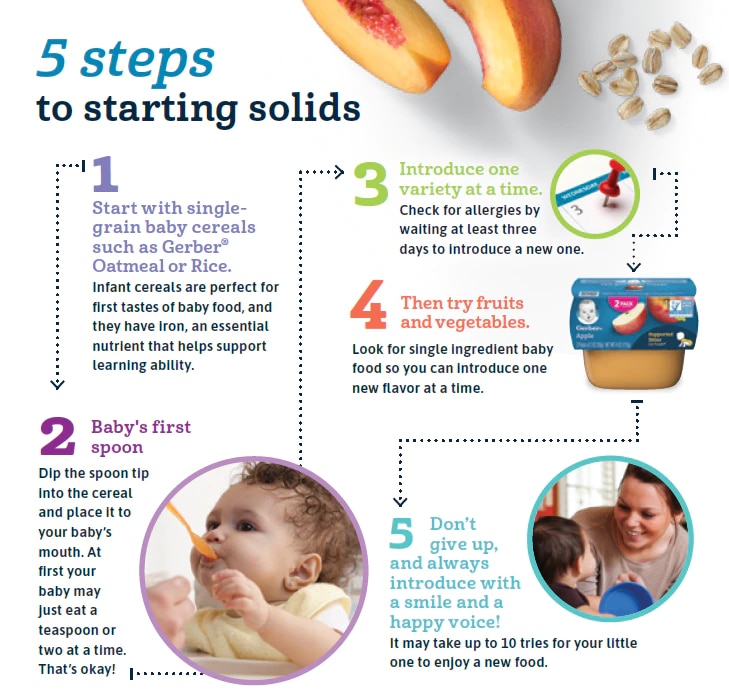Introducing solid foods to your baby’s diet is an important milestone. With the right guidance and care, you can ensure a smooth transition and a healthy start to their relationship with food.
As a parent, it’s crucial to understand when and how to introduce solid foods, as well as which foods are appropriate for this stage of your baby’s development. This guide will provide you with the insights and tips you need to confidently navigate this exciting phase.
From understanding the signs of readiness to navigating potential allergies and creating nutritious, delicious meals, you’ll be well-equipped to make informed decisions that support your baby’s health and well-being. Let’s explore the wonderful world of introducing solid foods to your baby!

Credit: www.amazon.com
When To Start
When to Start: A Guide to Introducing Solid Foods
Introducing solid foods to your baby is an exciting milestone, but it’s essential to choose the right time to start. To ensure your little one is ready for this new adventure, there are a few developmental milestones and signs of readiness to consider.
Developmental Milestones
Babies develop at their own pace, and each child is different. However, there are a few common developmental milestones to watch for as you contemplate introducing solid foods.
| Developmental Milestone | Description |
|---|---|
| Head Control | Baby can hold their head upright without support. |
| Seated Stability | Baby can sit with minimal support and maintain a stable position. |
| Tongue Reflex | Baby’s tongue-thrust reflex, which automatically pushes out anything placed in the mouth, has diminished. |
| Curiosity for Food | Baby shows interest in watching others eat, reaches for food, or mimics chewing motions. |
Signs Of Readiness
Watching out for these signs will help you assess if your baby is ready for solid foods:
- Ability to sit on their own without assistance.
- Showing eagerness and reaching for food when you’re eating.
- Swallowing reflex, demonstrated by the reduced incidence of tongue thrust.
- Increased appetite even after breastfeeding or formula feedings.
- Source of nutrients: Babies need more iron and zinc by around six months of age, which solid foods can provide.
It’s important to note that babies typically start showing these signs between four to six months of age. However, every child is unique, so it’s crucial to consult with your pediatrician before initiating solid foods. They will guide you based on your baby’s individual needs and development.
Remember, introducing solid foods is an exciting journey for both you and your little one. By monitoring developmental milestones and recognizing signs of readiness, you can make this transition a smooth and enjoyable experience for your baby.
Choosing The Right Food
Introducing solid foods to your baby can be exciting but also overwhelming. Baby’s First Spoonful is a comprehensive guide that will help you navigate the process of choosing the right foods for your little one’s first tastes. With helpful tips and expert advice, you can ensure that your baby’s introduction to solid foods is both nutritious and enjoyable.
Choosing the right food is a crucial step when introducing solid foods to your baby. It’s essential to consider their nutritional needs, tastes, and potential allergies.
Single-grain Cereals
When your baby is ready to start on solids, single-grain cereals are an ideal choice. They are a gentle way to introduce new textures and flavors. Opt for iron-fortified cereals to provide crucial nutrients for your baby’s development.
Pureed Fruits And Vegetables
Pureed fruits and vegetables are fantastic options when exploring different flavors and essential nutrients. Choosing organic produce reduces the risk of exposure to pesticides. Introducing a variety of flavors early can help expand your baby’s palate. Remember, it’s important to pay attention to any signs of allergies or sensitivities when introducing new foods. Observing how your baby reacts can aid in identifying any intolerances early on. Always consult with a pediatrician before introducing new foods.
Introducing New Foods
Baby’s first spoonful of solid food is a momentous occasion for both parents and little ones alike. As your baby reaches the age to start exploring new tastes and textures, introducing new foods can be both exciting and nerve-wracking. In this guide, we’ll discuss the importance of the gradual introduction of new foods and the consideration of allergenic foods in your baby’s diet.
Gradual Introduction
Introducing new foods to your baby should be done gradually to allow their taste buds and digestive system to adjust. Start with single-ingredient purees, such as mashed bananas, sweet potatoes, or pureed peas. As your baby gets used to the new flavors, gradually introduce more complex flavors and textures. It’s important to pay attention to any signs of allergies or sensitivities during this process.
Allergenic Foods
When introducing allergenic foods to your baby, it’s essential to proceed with caution. Common allergenic foods include peanuts, eggs, dairy products, fish, and soy. Always introduce these foods one at a time, allowing a few days in between to monitor for any adverse reactions. Be mindful of any family history of food allergies when deciding which foods to introduce.

Credit: www.gerber.com
Feeding Techniques
Feeding techniques are an important aspect of introducing solid foods to your baby. Two popular methods that parents commonly follow are spoon-feeding and baby-led weaning. Both techniques have their own benefits and considerations, allowing you to choose the approach that suits your baby’s needs and development. Let’s explore each method in detail:
Spoon-feeding
Spoon-feeding is a traditional method of introducing solid foods to your baby. It involves using a small baby spoon to feed your little one purees and mashed foods. Spoon-feeding allows you to have more control over what and how much your baby eats. It’s a great option for babies who are developmentally ready and comfortable with the idea of being fed by their parents.
When spoon-feeding your baby, it’s important to:
- Start with smooth and runny purees to make swallowing easier for your baby.
- Feed your baby in an upright position to minimize the risk of choking.
- Offer small spoonfuls of food and let your baby control the pace of eating.
- Gradually introduce different tastes and textures, as your baby becomes more accustomed to solid foods.
Baby-led Weaning
Baby-led weaning is a method that involves allowing your baby to self-feed from the very beginning of their solid food journey. Instead of spoon-feeding purees, you offer your little one appropriate-sized pieces of food that they can pick up and eat independently. This method encourages your baby to explore different tastes, textures, and develop their hand-eye coordination.
When practicing baby-led weaning, it’s important to:
- Ensure that food is cut into appropriate sizes to prevent choking hazards.
- Supervise your baby closely during mealtime to ensure their safety.
- Offer a variety of nutritious foods to encourage a well-balanced diet.
- Allow your baby to control their own eating pace and only offer breast milk or formula alongside solids.
Ultimately, the choice between spoon-feeding and baby-led weaning depends on what works best for your baby and your family. Some parents even choose a combination of both methods to incorporate variety and independence into their baby’s solid food experience. The key is to ensure that you are providing nutritious foods and creating a positive and enjoyable feeding environment for your little one.
Common Challenges
Introducing solid foods to your baby is an exciting milestone, but it can also come with its fair share of challenges. As you embark on this new adventure, it’s important to be prepared for some common hurdles that you may encounter along the way. From food rejection to digestive issues, being aware of these challenges can help you navigate the process with ease and confidence.
Food Rejection
One of the most common challenges parents face when introducing solid foods to their baby is food rejection. It’s not uncommon for babies to be picky eaters or to have preferences when it comes to flavors and textures. If your little one seems to turn up their nose at certain foods, don’t be discouraged. It can take several attempts before a baby develops a taste for a new food. Patience and persistence are key in overcoming this challenge.
Digestive Issues
Another challenge that parents may encounter is digestive issues. When introducing new foods, your baby’s sensitive digestive system may take some time to adjust. This can lead to issues such as gas, bloating, constipation, or diarrhea. To minimize these problems, it’s important to introduce new foods gradually and observe your baby’s reactions. Additionally, opting for gentle and easily digestible foods, such as pureed fruits and vegetables, can help ease the transition and reduce the likelihood of digestive discomfort.

Credit: babyfoode.com
Frequently Asked Questions On Baby’s First Spoonful: A Guide To Introducing Solid Foods
What Solid Food Should I Introduce To My Baby First?
Introduce single-grain cereals (like rice or oatmeal) to your baby first. They are easy to digest. Start with a thin consistency, gradually making it thicker. Offer fruits and vegetables next, cooked and mashed. Finally, introduce protein-rich foods like meats, poultry, and fish.
What Is The 3 Day Rule For Introducing Solids?
The 3 day rule for introducing solids is the practice of waiting 3 days between each new solid food introduction to monitor for allergies and intolerances in infants. This approach helps to identify any adverse reactions caused by specific foods.
What Is The Best Guide For Starting Baby On Solids?
The best guide for starting your baby on solids includes introducing single-ingredient purees, observing for allergies, and gradually increasing variety and texture. Follow baby’s cues, offer a variety of flavors, and prioritize nutrient-rich foods. It’s important to seek guidance from a pediatrician for your baby’s specific needs.
Can I Give My 4 Month Old Baby Food?
No, it is not recommended to give solid foods to a 4-month-old baby. Breast milk or formula provides essential nutrients for their growth. It is best to wait until around 6 months when your baby’s digestive system is more developed and they can sit up and show signs of readiness for solid foods.
Conclusion
Introducing solid foods to your baby can be an exciting but nerve-wracking experience. By following the steps outlined in this guide, you can ensure a smooth transition. Remember to gradually introduce different foods, carefully monitor for any allergies, and prioritize nutrient-rich options.
By providing a variety of tastes and textures, you can lay the foundation for a healthy eating journey. So, take a deep breath, trust your instincts, and savor this milestone moment with your little one. Happy feeding!

